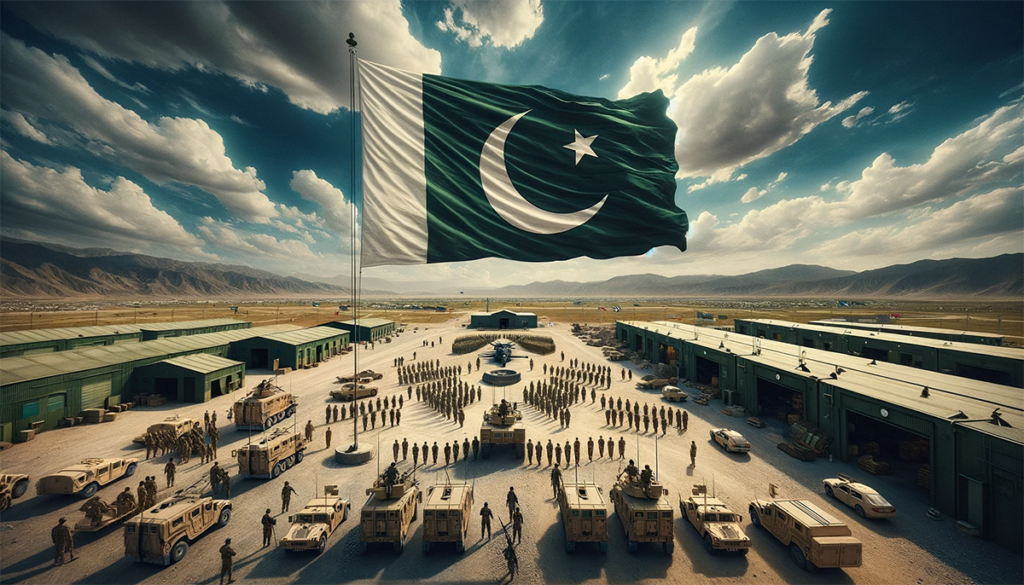
Flag of Pakistan flying over a military base (DALL-E 3)
Understanding Pakistan’s Ababeel Missile Test in the Context of South Asian Strategic Stability
In the ever-evolving landscape of South Asian defense dynamics, Pakistan’s recent missile test stands as a significant event. The successful launch of the Ababeel missile, a multiple independently targetable re-entry vehicle (MIRV) capable system, marks a critical milestone in the country’s strategic capabilities. This development, occurring against the backdrop of India’s expanding ballistic missile defense (BMD) program, is a pivotal moment in understanding the delicate balance of power in the region.
Pakistan’s Strategic Response: A Defensive Maneuver
Pakistan’s decision to test the Ababeel missile after a six-year hiatus is deeply rooted in strategic considerations. The test, conducted in late October 2023, is more than just a display of military might; it’s a nuanced response to evolving security challenges. The Ababeel system, with its MIRV capabilities, is seen as a crucial component of Pakistan’s policy of “full spectrum deterrence under credible minimum deterrence.” This approach is inherently defensive, aimed at maintaining strategic stability rather than altering the status quo.
The Ababeel Missile: Ensuring Deterrence Survivability
The development of the Ababeel missile is a direct answer to the perceived threats from India’s burgeoning BMD program. The Ababeel’s capability to deliver multiple warheads independently is not just a technical feat but a strategic one, ensuring the survivability and efficacy of Pakistan’s ballistic missile arsenal in a rapidly changing security environment.
India’s BMD Program: A Catalyst for Regional Arms Dynamics
India’s BMD program, initiated in the 1990s, has been a significant driver of regional defense developments. The successful test of the first interceptor in 2006 placed India alongside major powers like the United States, Israel, and Russia in the realm of anti-ballistic missile capabilities. The system, designed to shield key areas like New Delhi and Mumbai, consists of two tiers: the Prithvi Air Defense Vehicle (PAD)/Prithvi Defense Vehicle (PDV) and the Ashwin Advanced Air Defense (AAD). These systems can intercept threats at both exo-atmospheric and endo-atmospheric altitudes, showcasing India’s commitment to a comprehensive defense strategy.
Expanding Horizons: India’s Phase 2 Trials and Beyond
The AD-1 interceptor, tested in November 2022, marked the beginning of Phase 2 trials of India’s BMD system. This phase aims to significantly extend the range of interception, showcasing India’s intent to enhance its defensive posture. The development of new BMD radar sites and the introduction of sea-based BMD capabilities further underline India’s determination to build a robust defense shield.
Pakistan’s Counter-Move: The Ababeel Test as a Strategic Statement
Pakistan’s latest Ababeel test is a clear response to the advancements in India’s BMD capabilities. This move can be interpreted as an effort to maintain credible deterrence and assure mutual vulnerability, a cornerstone of regional strategic stability. The test signifies Pakistan’s determination to safeguard its sovereignty and territorial integrity against any form of external aggression or strategic dominance.
A Delicate Balance: Understanding the Regional Implications
The ongoing developments in South Asia’s missile defense capabilities highlight a delicate balance. While on the surface, BMD systems are defensive, their implications in a nuclearized region are far-reaching. The presence of advanced missile defense systems could potentially embolden preemptive strategies, thereby escalating tensions and undermining strategic stability.
Navigating a Path Towards Sustained Peace
The recent missile test by Pakistan, set against the backdrop of India’s expanding BMD capabilities, underscores the complexities of South Asian security dynamics. It serves as a reminder of the need for continued dialogue and confidence-building measures to ensure that these technological advancements do not become catalysts for conflict but rather tools for maintaining peace and stability in the region.








